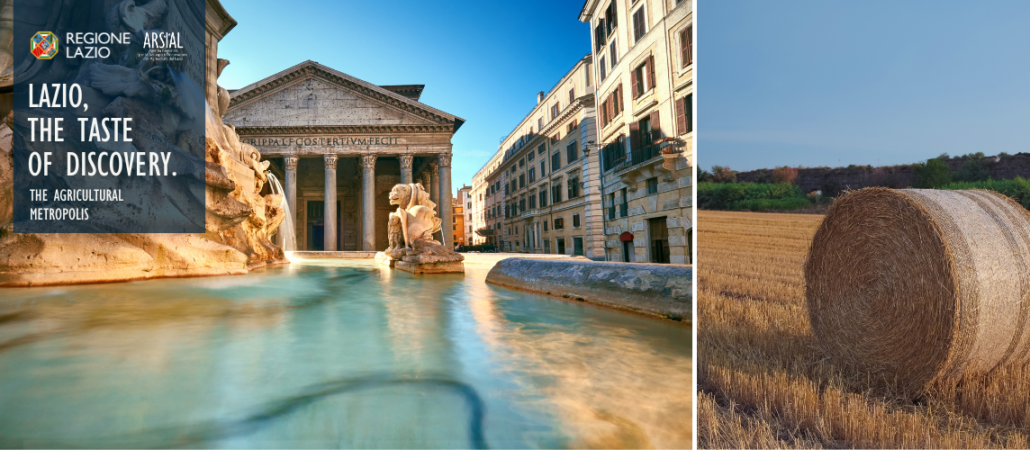Rome is the largest agricultural city in Europe, with over 63.000 hectares of arable land. The deep relationship between the urban metropolis and the fertile countryside is the result of a thousand-year history. Would you like to know more?
Rome, the Eternal City, is universally known as “The cradle of civilization”, but few people also know its great agricultural tradition, despite a thousand-year history. Even today, Rome holds the title of the largest agricultural municipality in Europe, with over 63.000 hectares of arable land, 10.000 of which are publicly owned.
Rome’s agricultural attitude has very ancient roots. The ager Romanus, the Roman countryside, was a mosaic of golden fields, vineyards and vegetable gardens, where the “rusticians” worked tirelessly to feed the population. Ancient Romans had a deep respect for the land, and Rome’s agricultural traditions were celebrated in the most illustrious texts of antiquity.
Over the centuries, agriculture remained an essential element of Roman life. The surrounding lands still produce high quality products today: award-winning wines, vegetables, pecorino cheeses, succulent meats, extra virgin olive oil and unique specialties such as “Caciofiore“, a soft cheese prepared according to the techniques described by Lucio Giunio Moderato Columella in De re rustica almost two thousand years ago.
Rome’s agricultural heritage, together with its great culinary tradition, is a harmonious fusion of history and modernity. The agricultural production, which reaches the markets, farmer’s markets and shops of the capital every day from the countryside and the surrounding areas, expresses an authentic passion for food and wine and the rural world, deeply rooted in the very spirit of the city.
LA METROPOLI AGRICOLA
Roma, la Città Eterna, è universalmente nota come “La culla della civiltà”, ma ancora in pochi conoscono sono la sua grande tradizione agricola, malgrado una storia millenaria. Ancora oggi Roma detiene il titolo di comune agricolo più vasto d’Europa, con oltre 63.000 ettari di terre coltivabili, 10.000 dei quali di proprietà pubblica.
La vocazione agricola di Roma ha radici antichissime. L’ager Romanus, la campagna romana, era un mosaico di campi dorati, vigneti e orti, dove i “rustici” lavoravano instancabilmente per nutrire la popolazione. I Romani antichi nutrivano un profondo rispetto per la terra e le tradizioni agricole di Roma sono state celebrate nei testi più illustri dell’antichità.
Nel corso dei secoli, l’agricoltura è rimasta un elemento essenziale della vita romana. Le terre circostanti producono ancora oggi prodotti di grande qualità: vini rinomati, ortaggi, formaggi pecorini, carni succulente, olio extravergine e specialità uniche come il “Caciofiore” formaggio a pasta molle preparato secondo le tecniche descritte da Lucio Giunio Moderato Columella nel De re rustica quasi duemila anni fa.
Il patrimonio agricolo di Roma, unito alla sua grande tradizione culinaria, è un’armoniosa fusione di storia e modernità. Le produzioni agricole, che dalla campagna e dalle aree circostanti raggiungono tutti i giorni mercati, farmer’s market e punti vendita della Capitale, esprimono una passione autentica per l’enogastronomia e il mondo rurale, profondamente radicate nello spirito stesso della città.
DIE LANDWIRTSCHAFTLICHE METROPOLE
Rom, die Ewige Stadt, ist allgemein als „Wiege der Zivilisation“ bekannt, aber nur wenige kennen ihre große landwirtschaftliche Tradition. Noch heute hält Rom den Titel der größten landwirtschaftlichen Gemeinde Europas, mit über 63. 000 Hektar Ackerland, von denen 10. 000 in öffentlichem Besitz sind.
Die landwirtschaftliche Berufung Roms hat sehr alte Wurzeln. Der Ager Romanus das römische Land- war ein Mosaik aus goldenen Feldern, Weinbergen und Gemüsegärten, wo die “Rustiker” unermüdlich arbeiteten, um die Bevölkerung zu ernähren. Die alten Römer hatten einen tiefen Respekt vor dem Land, und die landwirtschaftlichen Traditionen Roms wurden in den berühmtesten Texten der Antike gefeiert.
Im Laufe der Jahrhunderte blieb die Landwirtschaft ein wesentlicher Bestandteil des römischen Lebens. Die umliegenden Länder produzieren auch heute noch hochwertige Produkte: berühmte Weine, Gemüse, Pecorini-Käse, saftiges Fleisch, Olivenöl extravergine und einzigartige Spezialitäten wie den Weichkäse “Caciofiore”, der nach den von Lucio Giunio Moderato Columella in “De re rustica” vor fast zweitausend Jahren beschriebenen Techniken zubereitet wird.
Das landwirtschaftliche Erbe Roms, zusammen mit seiner großen kulinarischen Tradition, ist eine harmonische Verschmelzung von Geschichte und Moderne. Die landwirtschaftlichen Erzeugnisse, die täglich auf den Märkten und in den Verkaufsstellen der Hauptstadt landen, sind Ausdruck einer echten Leidenschaft für Wein- und Gastronomie und die ländliche Welt, die tief verwurzelt ist.
PRODUCTS/PRODOTTI/PRODUKTE
Selections/Selezione/Auswahl
“ABBACCHIO ROMANO” IGP
“RICOTTA ROMANA” DOP
“PECORINO ROMANO” DOP
“POCHETTA DI ARICCIA” IGP
“COPPIETTE” PAT *
“MORTADELLA ROMANA” PAT *
“CORALLINA ROMANA” PAT *
“CACIOTTA GENUINA ROMANA” PAT *
“CIAMBELLE AL VINO E ALL’ANICE” PAT *
“CIRIOLA ROMANA” PAT *
“CACIOFIRE DELLA CAMPAGNA ROMANA” PAT *
“PIZZA BIANCA ROMANA ALLA PALA DEL FORNAIO” PAT *
* PAT is an official approval for traditional Italian regional food. A list of approved products is published by the Ministry of Agriculture, Food Sovereignty and Forestry.
* PAT ist eine offizielle Zulassung für traditionelle italienische regionale Lebensmittel. Eine Liste der zugelassenen Produkte wird vom Ministerium für Landwirtschaft, Ernährungssouveränität und Forsten veröffentlicht.



